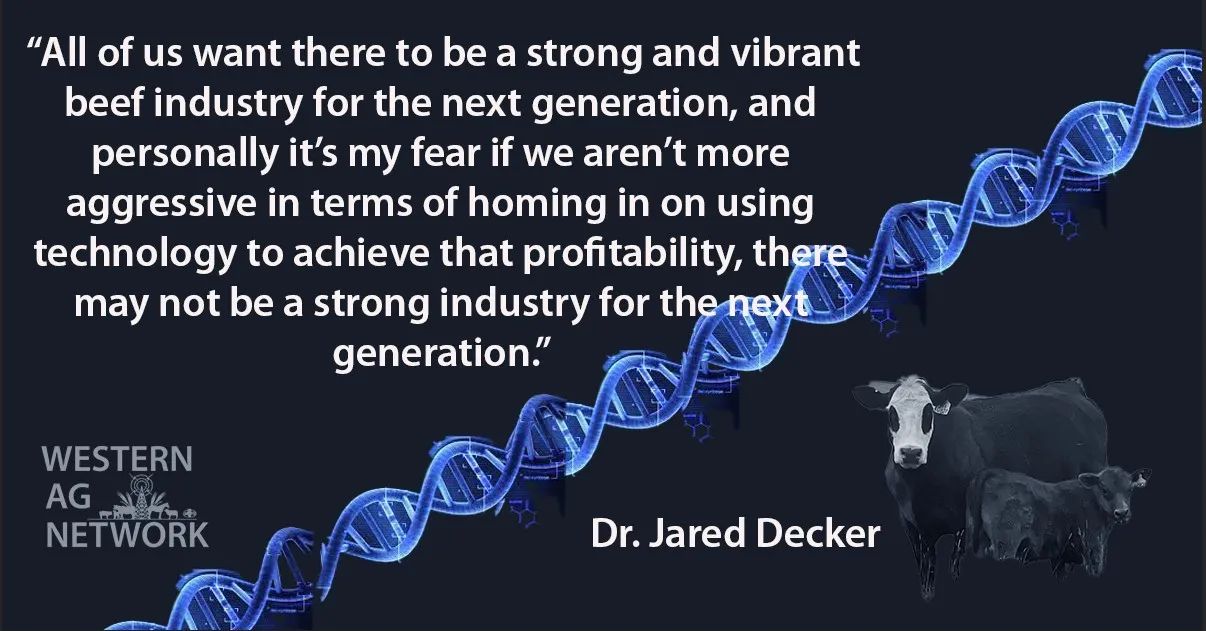
DNA Test a Profitability Tool for the Commercial Cowman
August 7, 2023 — Profitability is increased by either reducing costs, or increasing the value of the commodity sold, which for many cattle producers, can be a moving target. University of Missouri Associate Professor in Computational Genomics in the Division of Animal Sciences Dr. Jared Decker is using his research to put the power of gene prediction in the hands of cattle producers.
In partnership with the American Angus Association, Decker and his partners at the Thompson Research Farm tested a group of commercial Angus cows using a commercial genomic prediction tool from Zoetis called GeneMax Advantage. The study put the DNA test to the test, measuring its ability to predict calf performance and profitability. Decker found significant relationships between the cows’ genetic merit and the performance of their calves.
For the study, researchers focused on specific traits, such as weaning and carcass weight, marbling, fat, and ribeye area. Decker said the pool of about 300 commercial Angus cows were tested with the DNA test and researchers also had in hand the performance data on the calves of those cows over a 15-year period.
“We simply compared the performance data of the progeny, of the calves to the mothers, to the cows and we asked if there was a significant statistical relationship between these two things,” Decker said. “And for all the traits we had data on, the answer was yes.”
One important clarification he offered is that genetic prediction and enhanced performance data or EPDs, are answering the same question.
“The difference is in a commercial beef operation we often don’t keep track of pedigree information and performance data like we do in a seedstock operation so what this DNA test allows us to do is to simply skip all of those steps in terms of recording pedigrees and recording performance data and get to the answer of what is the genetic prediction, the genetic merit of this cow,” he said. “It’s an EPD just based on DNA test results.”
The study, he said, considers the big picture of data. By evaluating all the data in the set, the researcher isn’t influenced by one piece of data that may be an incorrect data entry, which resolves some human error. The total data set reflects the estimates. Decker said the DNA testing from a seedstock perspective doesn’t remove the need for the phenotype, but instead makes it more valuable as more information is squeezed from the data records.
The DNA sample can be pulled at any point in the female’s life, be it at birth or when she is a bred heifer, the results have about a two-to-three-week turnaround period, and the test is $28.
“In terms of cost, one of the points I always try to consult with beef producers about is they really need to be marketing their animals in such a way that they can see a return on investment for using the DNA test to create a superior calf crop,” he said. “So, if you’re creating a genetically superior calf crop, but you’re marketing it as a commodity, you’ve not really done anything to give yourself an opportunity to see a return on that investment.”
In the field, he said the producers who are seeing the return on investment are marketing their calves wither through a value-added program or retaining ownership in the feedlot. Decker said there have been countless validation studies of indexes, of EPDs, of DNA testing, and time and time again, those technologies are validated and shown to work.
“As a beef industry, we need to stop asking whether this 40-year-old technology works, in the case of EPDs, or this 11-year-old technology works, in terms of genetic prediction, and ask how to use this technology to be more profitable in my operation. Do the strategic thinking of making genetic decisions to really focus on profitability,” he said. “All of us want there to be a strong and vibrant beef industry for the next generation, and personally it’s my fear if we aren’t more aggressive in terms of homing in on using technology to achieve that profitability, there may not be a strong industry for the next generation.”
Source: Western Ag Network










